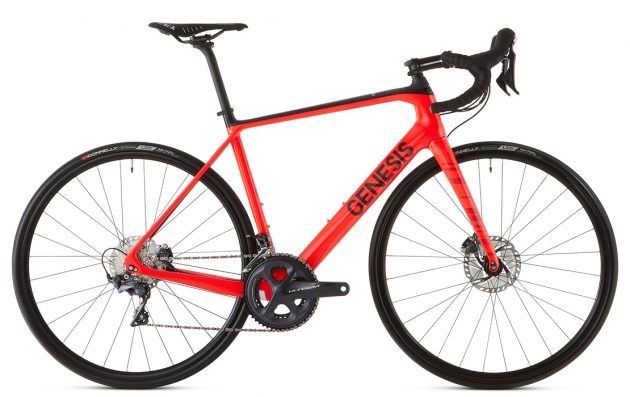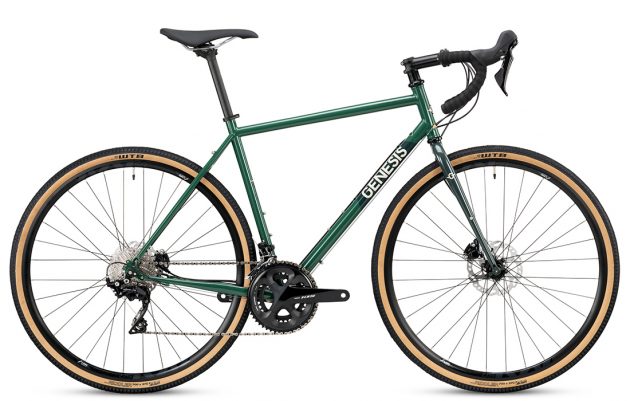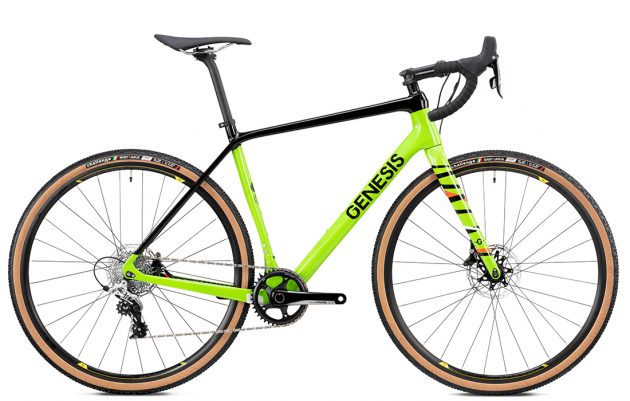Genesis bikes range: carbon race bikes and stunning steel frames

Not quite mainstream, yet still hugely popular, Genesis Bikes are a British brand loved by steel-aficionados and adventurers alike.
Despite being already expansive, the Genesis Bikes brand continues to grow, with the British company striking out even further to the gravel/adventure cross market.
That's not to say that they've forgotten the road market. A solid steel range and a smattering of aluminium and carbon models brings the brand bang up to date.
>>> Should your next bike be carbon, aluminium, steel or titanium?
So many models are offered that it can be hard to choose exactly which bike is best for you. We've split this guide up into four large sections; road bikes, adventure bikes, cyclocross bikes, and utility bikes, detailing each of the bikes in the range and how they differ from the others. If you're a dyed in the wool roadie or complete 'cross-head, you can jump straight to the section that interests you most.
Useful links for road bike shoppers…
| Brands/topics | Model overviews and reviews |
| BMC bikes | BMC bike reviews |
| Boardman | Boardman bike reviews |
| Cannondale | Bike reviews,SuperSix Evo,CAAD12,Synapse |
| Canyon bikes | Canyon bike reviews |
| Carrera bikes | Carerra bike reviews |
| Cervelo bikes | Cervelo bike reviews |
| Cube bikes | Cube bike reviews |
| Focus bikes | Focus bike reviews |
| Genesis bikes | Genesis bike reviews |
| Giant bikes | Giant bike reviews,Giant Defy,Giant Propel,Giant TCR |
| Pinarello | Pinarello bike reviews |
| Raleigh bikes | Raleigh bike reviews |
| Ribble bikes | Ribble bike reviews |
| Scott bikes | Scott bike reviews |
| Specialized | Bike reviews,Allez,Tarmac,Diverge |
| Trek bikes | Bike reviews,Domane,Emonda,Madone |
| Price points | Bikes under £500,under £1000,under £1500,under £2000 |
| Road bike styles | Aero road bikes,Endurance road bikes,Women’s road bikes,Commuting bikes,Touring bikes,Singlespeed bikes,Track bikes,Time trial bikes |
| Other bike styles | Adventure and gravel bikes,Cyclocross bikes,Electric bikes,Hybrid bikes |
Road bikes
As the name suggests, these are bikes that are designed for the explicit purpose of riding on the road. Some are more race oriented, meaning mudguard and pannier mounts are forgone and the geometry is longer and lower. Others have more of an endurance focus, better suited to long rides and have all the mounts you need for light cycle-touring.

Delta
These are Genesis’ entry-level road bikes and are the cheapest in their range. The geometry is a little more upright, making for a more comfortable and less twitchy ride. There are mounts for mudguards and a pannier rack, which expands the range of use from just road riding to commuting and even lightweight cycle touring.
>>> Commuting to work: what you'll need
There are three different spec levels, with 10 being the entry level, 20 the mid-range and 30 being the top of this range. For the entry level, you’ll get a Shimano Claris 2x8 drivetrain, an aluminium frame and carbon fork. Whilst the 30 model gets a Shimano 105 2x11 drivetrain, along with the aluminium frame and carbon fork.
In this range there are also women’s specific models - in addition to the unisex ones. There are donated by a ‘W’ at the end of the name. With these bikes, the saddles have been changed for a women specific model as well as shorter cranks and narrower handlebars being specced to better suit female proportions.
>>> Is ‘women’s specific geometry’ still relevant?
See the Genesis Delta range here

Reasons to buy
Reasons to avoid
The steel tubes of these endurance bikes, with their ability to dampen the road buzz, make them perfectly suited to long days out in the saddle. Pannier and mudguard mounts are also present on these frames, adding to their versatility. The external cable routing and threaded bottom brackets are also features that will be well apricated by home mechanics.
The bikes are available either with rim brakes or hydraulic discs, but there is only one spec level with these bikes. Both come with 2x11 Shimano 105 drivetrains and carbon forks. The rim brake version can take tyres up to 28c, whereas the disc version can handle 30c.
If you want more control over exactly what components your bikes is built with, both of these are available to buy as just the frameset.
See the Genesis Equilibrium range here

Zeal
For those interested in dipping their toes into racing, or just want a sportier feeling bike, the Zeal range is Genesis’ entry level carbon option. The geometry is more aggressive than the endurance-oriented Equilibrium, but not quite as ‘head-down bum-up’ as the dedicated racers that are the Zeros.
The aero features of more expensive bikes are present, with cables are routed internally and the leading edges of the frame are smoothly rounded. The groupset is Shimano Tiagra with a 2x10 drivetrain while the maximum tyre size is 25c.
See the Genesis Zeal range here

Zero
These are the dedicated carbon race bikes, as ridden by the (now disbanded) UCI continental team Madison Genesis. The frame has internally routed cables for better aerodynamics and a wide section down tube for better torsional stiffness. The frame is also compatible with Shimano Di2 internal routing.
A rim brake version is available in addition to the disc option and both come with Shimano Ultegra 2x11 groupsets. It is only available in a unisex configuration, however. The maximum tyre size on bike is 28c, typical for rim brake set ups but relatively narrow for a bike with discs. But for races that are solely on roads, this should be more than adequate.
See the Genesis Zeal range here
Adventure bikes
These bikes are designed for longer days out being able to handle heavier loads and rougher roads. There is something of a sliding scale. Some bikes (such as the Fugio) are more oriented towards the rough stuff, whereas others (such as the Croix de Fer) are better suited to carrying loads.
Just because a bike is designed for one specific purpose doesn’t mean it is limited to that purpose. Adventure bikes are very versatile and can be put to a multitude of uses.

Croix de Fer
The Venerable Croix de Fer frameset has been a mainstay of the Genesis range since 2009. The frameset is incredible versatile and lends itself to a multitude of different builds. You could put 38c tyres on it and go bike-packing on some gravel, or you could put front and rear pannier racks on, throw in some mudguards, and take it on an around the world tour. You could even commute, go on road rides, use it as a utility shopper. Basically, everything.
Other bikes might have the specificity to perform better in a single one of these uses, but very few bikes would be able to perform as well as the Croix de Fer in all of them. It is the combination of a vast array of mounts, a robust steel frame and wide tyre clearances that allow this bike to be such a jack of all trades.
Given the versatility of this frame, it is perhaps to be expected that there is a large number of different builds on offer. It is available with flat bars and drop bars, carbon forks and steel forks, there’s even a titanium frame option. For each of the builds, there are different spec levels donated by a ‘10’ for the entry level and ’30’ for the top line.
See the Genesis Croix de Fer range here

CDA
Essentially an aluminium version of the Croix de Fer, the CDA features a similar plethora of mounts and wide clearances but comes in at a significantly lower price. Part of this is down to the different frame material, but cheaper components are also a factor.
With a 2x9 Shimano Sora groupset and mechanical disc brakes, there are notable differences to the higher end Croix de Fer. But these won’t present an impediment to getting out and using the frame for the huge variety of applications it has the capability for. Gravel riding, endurance road riding, cycle-touring, commuting, these are all still possible on this bike – it’s just a more accessible platform to get started with.
See the Genesis CDA range here

Fugio
The Fugio is a rowdier bike than the Croix de Fer, more suited to playing around on the trails and using the bumps as a platform to get some air. The dropper seatpost, slacker head angle, shorter chainstays and clearance for tyres up to 50mm wide on 650b wheels are responsible for this more playful handling.
Versatility still pervades the frame, with downtube bottle bosses and mounts for a rear rack and mudguards. Although this bike can take on the commuting duties or a bit of cycle-touring, it is more suited to lively riding in the woods and on bridleways.
If you’re looking for a fun bike that can also do the grunt-work when required, this is the one for you. But if you want a dedicated workhorse, the Croix de Fer or Equilibrium will probably suit you better.
See the Genesis Fugio range here

Datum
Some adventures are about taking your time and drinking in your surroundings, others are about getting there fast. This bike is designed for lightweight bike-packing, able to tackle ultra-distances on mixed terrain.
There aren’t mounting points for front or rear pannier racks; strap on bike-packing bags are the weapon of choice here. Some practically remains, with downtube bottle bosses (useful for holding extra water or a tool keg) and discrete mudguard mounts. The frame is fully carbon and the cables are integrated into the frame for a cleaner look and better aerodynamics.
The Datum comes with 32c tyres, which is a bit closer to the ‘road’ end of the spectrum. But there is clearance for up to 38c, so if the conditions require it, this bike is able to handle the rougher stuff.
See the Genesis Datum range here
Cyclocross bikes
These may look very similar to the adventure bikes at first glance, but there are some very important (although subtle) differences. The most significant is in the geometry: these bikes are designed for short, hard, and fast races and have the geometry to match. The steering is more sensitive for quick changes of direction and the front end is lower for a more aggressive position on the bike.
Although the two bikes in this section might both be called the ‘Vapour’ with only the epithets ‘Alloy’ and ‘Carbon’ differentiating them, there are actually significant distinctions to be made.

Vapour Carbon
This is an all-out racing ‘cross bike. The angles are steep, the front end is low and there aren’t mudguard or pannier mounts. 33c tyres are specced (the maximum permitted in UCI sanctioned cyclocross races), while the maximum tyre size recommend is 35c. There’s still masses of mud clearance though.
Due to being disc brake only, the bridge between the seatstays could be removed. This further increases mud clearance and also adds to the frame’s compliance, providing better control. Definitely not a versatile bike; this is designed with only CX racing in mind and makes no compromises - except for, perhaps, its two sets of bottle bosses.
See the Genesis Vapour Carbon range here

Vapour Alloy
Ostensibly, this is a more budget-oriented version of the Vapour Carbon. The aluminium frame is cheaper, although the fork is still carbon. Disc brakes remain present, but they have been changed to mechanical rather than hydraulic. The drivetrain is still a performance oriented 1x11 set up and, in all, this is still a competitive racing machine.
There are, however, a number of points that make this a more versatile bike than the carbon alternative. Tyre clearance is increase to 38c, there are discrete mudguard and pannier mounts and an extra set of bottle bosses is present on the downtube.
Although not quite as aggressive and steep as the carbon version, it is still more so than the adventure bikes, which makes it more suited to the racing that cyclocross demands.It can also do much of what an adventure bike can - and you could take an adventure bike to a CX race - but each bike will performance best at what it is specifically designed for.
See the Genesis Vapour Alloy range here
Utility bikes
With pannier rack mounts and similar geometry,these bikes may look similar to the adventure bikes, but there are a few features that make these better suited to running errands and commuting than a dedicated adventure bike would be. Prefitted mudguards and more puncture resistant city tyres are such examples.

Day one
This is a firm contender for the ‘dream commuter’ bike. The basics are there in full length mudguards, a rear pannier rack, and puncture resistant tyres. With clearance for tyres up to 38c and a steel frame that will be robust and help deaden the road chatter, this is a bike with the stamina to match your own.
But more than that, there’s front and rear dynamo lights, so you never need worry about forgetting/neglecting to charge your lights. An internally geared hub goes a long way to weather proofing the drivetrain, as do the full housed gear cables that help stop dirt degrading your shifting performance.
See the Genesis Day One range here

Flyer
Almost the antithesis of the Day One, the Flyer is sublime in its simplicity. It employs easily adjustable rim brakes, a single 42x17 gear, and it has mudguards to keep the spray off. Although the frame is steel, it’s relatively lightweight with a carbon fork and no excess components weighing it down. This is a bike that will zip around town without a second thought.
See the Genesis Flyer range here

Smithfield
For short, but heavily laden trips around town, the Smithfield presents an intriguing option. The swept back flat bar put you in a comfortable, upright position for better navigating traffic, while the hydraulic disc brakes provide strong and controlled stopping power.
As with the Day One, there are mudguards, rear pannier rack, and an internally geared rear hub for all weather dependability.
See the Genesis Smithfield range here
The latest race content, interviews, features, reviews and expert buying guides, direct to your inbox!